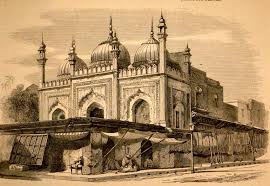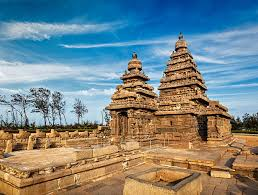Q. How did the city layout and courtly culture of Vijayanagara reflect the dominance of Imperial control?
The City
Layout and Courtly Culture of Vijayanagara: Reflection of Imperial Control
The city of Vijayanagara,
established as the capital of the Vijayanagara
Empire (1336–1646), is an outstanding example of how urban planning,
architectural features, and courtly culture can be used to demonstrate the
dominance and centralization of imperial control. The empire itself, located in
the Deccan plateau of southern India, was one of the most powerful and
prosperous Indian states during its time, and its capital, Hampi, was one of the largest cities in
the world in the 16th century. The layout of the city, its monumental
architecture, and the rituals and practices of courtly culture all serve as key
indicators of the empire’s imperial control over its vast territory, as well as
its political, social, and cultural hegemony.
1. City
Layout: A Reflection of Imperial Power
The city of Vijayanagara
(particularly the area around Hampi,
the primary site) was a highly planned urban center that reflected both the centralized control of the empire and
the cosmic vision of the rulers.
The layout was designed to embody imperial authority and the king’s divine
right to rule.
·
Capital as a Symbol of the Cosmos: The design of the city was symbolic, incorporating
both practical and religious dimensions. The city was divided into distinct
areas, each with specific functions, which were meant to reflect the order and
authority of the empire. It was based on the concept of a cosmic city where each element, such as
streets, temples, and markets, had symbolic meanings. The central axis of the
city aligned with religious significance, reinforcing the idea of the city as a
microcosm of the universe. This alignment of the city was intended to portray
the king as the central figure who governed not only the physical realm but
also the metaphysical domain.
·
The Royal Enclosure and Imperial Architecture: At the heart of the city lay the Royal Enclosure, a walled area that
housed the royal palace and other important administrative buildings. The
palatial complex was designed to be both an administrative center and a
symbolic representation of the king's power. Its grand gateways, pillared
halls, and enormous audience
chambers demonstrated the magnificence of the king's rule. These
structures, such as the Mahanavami Dibba
(a large platform used for state ceremonies), were symbolic of the emperor’s
divine authority and power. These monumental buildings reflected the absolute
control of the imperial family over the land and its people.
·
Walled and Fortified City: The city’s boundaries were clearly defined, with
massive fortifications and walls
surrounding the central urban areas. The presence of large gates and entry
points signified both physical and symbolic barriers to outsiders, asserting
the empire's territorial integrity and its military might. The city's layout,
with its defenses and controlled access points, reflected the dominance of the
Vijayanagara Empire over its surrounding territories. The fortifications were
not just defensive but also acted as a reminder of the empire’s control over vast
regions.
·
The Sacred and the Secular Divisions: Vijayanagara was divided into various sectors, each
designated for different functions. The sacred
and secular were spatially
separated, reflecting the hierarchical nature of the empire’s governance. The religious district housed temples,
including the grand Virupaksha Temple,
which was a major symbol of the city’s religious and cultural authority. The royal quarters, on the other hand, were
centers of political and administrative power. The careful separation of these
zones reinforced the centralization of power and the distinct roles of religion
and governance within the imperial system.
·
Water Systems and Infrastructure: One of the most remarkable aspects of the
Vijayanagara city's urban planning was its water management system. The tanks, reservoirs, and canals that
supplied water to the city were not only essential for sustaining a large urban
population but also symbolized the empire's control over resources. The tank system, for instance, was vital in
managing water for agriculture, drinking, and religious purposes. This system
of water control was a mark of imperial power, as it displayed the ability to
manage and distribute resources across the entire empire. The grand Step Wells and water reservoirs around the city signified the empire’s
technological advancements and organizational capabilities, reflecting a
stable, centralized state that could control the flow of natural resources.
2. Courtly
Culture and Imperial Authority
Courtly culture in the Vijayanagara Empire played an
equally important role in showcasing the authority and dominance of the
imperial rulers. The king, known as the Raya,
was seen not only as a political leader but also as a divine figure whose rule
was legitimized through rituals, patronage of the arts, and the administration
of justice. The courtly culture
of Vijayanagara was an extension of the city’s architectural grandeur, designed
to reinforce the centralization of power and the legitimacy of the monarchy.
·
The King as a Divine Ruler: In the Vijayanagara Empire, the king was not simply
a secular ruler but also a religious figure who held divine status. The Raya performed regular rituals and
religious ceremonies to maintain the cosmic order and legitimacy of his rule.
The rituals, often involving elaborate ceremonies and sacrifices, were
performed both within the palace complex and in the public spaces of the city.
This elevated the king’s status above that of an ordinary ruler, as he was seen
as the intermediary between the divine and earthly realms. These court rituals
often took place in grand open spaces such as the Mahanavami Dibba, where the king would address his
people and make public appearances.
·
Patronage of the Arts and Culture: The imperial court of Vijayanagara was a major
patron of the arts, and this played a significant role in reinforcing the power
of the emperor. Kings and nobles sponsored temples, monumental sculptures, and
elaborate frescoes. Temples were not just religious sites but were also symbols
of imperial patronage. The Virupaksha
Temple, for instance, was not only a place of worship but also a site
where royal power and wealth were on display. The arts were also used as a
means of communicating the strength and stability of the empire. The grand
architectural and artistic achievements of the city served to reinforce the
idea that the Vijayanagara Empire was powerful, divinely sanctioned, and firmly
in control.
·
Ceremonial Processions and Public Displays of Power: The imperial court regularly held ceremonial processions in which the king
would appear publicly, often accompanied by royal retainers and soldiers, to
assert his dominance and connect with the people. These processions were not
only political demonstrations but also acts of religious significance. For
example, during important festivals like Makar
Sankranti or Dussehra,
the king and the royal family would participate in large-scale processions,
highlighting their connection with both the divine and the political sphere.
Such events were critical for maintaining the authority of the monarch and
emphasizing the grandeur and legitimacy of the Vijayanagara state.
·
Military Power and Courtly Displays: The courtly culture of Vijayanagara was also tied to
military power. The kings of Vijayanagara, such as Krishnadevaraya, were known for their military prowess.
The presence of military leaders and generals at court was a reminder of the
empire's strength and its ability to defend and expand its territories.
Military victories were often celebrated in public festivals, and prisoners of
war were sometimes paraded through the streets, further asserting the king’s
dominance and military might. The military elite played an important role in
courtly rituals and processions, reinforcing the close relationship between the
king, his army, and his imperial authority.
3. The Role of
Religion and Temples in the Courtly Culture
Religion was a central pillar of both the city’s
layout and the courtly culture. Temples were not just places of worship but
also symbols of the ruler’s authority and centrality.
·
Temple Architecture and Imperial Patronage: The kings of Vijayanagara were major patrons of
Hindu temples. The Virupaksha Temple
is a prime example of this patronage, with its grand architecture, including
towering gopurams (gateway towers) and intricate sculptures that celebrated
both religious and royal themes. The construction of such temples by the
imperial family was seen as a means to legitimize their rule, as it reinforced
their role as defenders of dharma (moral law) and protectors of Hinduism.
·
Religious Festivals and the Court’s Role: Festivals were central to the courtly culture of
Vijayanagara. The king’s role in religious celebrations was integral to his
authority. During festivals like Dussehra,
the king would perform rituals at the royal temple, demonstrating both his
religious piety and his power as a ruler. These festivals provided an
opportunity for the king to showcase his wealth, display military power, and
demonstrate his connection to the divine order. The scale of these festivals,
with their processions, sacrifices, and feasts, served to reinforce the
monarch’s position as the central figure in the empire’s spiritual and temporal
life.
·
The Integration of Religion with Political Ideology: The Vijayanagara kings were devout Hindus, and their
religious practices often intertwined with their political ideology. The king
was regarded as the earthly representative of the gods, and his role in
maintaining order and prosperity was seen as divinely ordained. The state and
religion were not separate in the Vijayanagara Empire but were integrated into
a single political and spiritual framework. This made the city and its royal
court the focal point of both political and religious life in the empire.
Conclusion
The city layout and courtly culture of Vijayanagara
reflect the dominance of imperial control in multifaceted ways. The city’s
highly organized urban planning, with its sacred and secular divisions,
monumental architecture, water management systems, and military fortifications,
demonstrated the empire’s power and centralization. At the same time, the
courtly culture, including the divine status of the king, the patronage of the
arts, and the integration of religion into governance, reinforced the monarch’s
control over both the physical and spiritual domains of the empire.
Through
its urban design and courtly rituals, the Vijayanagara Empire projected an
image of stability, power, and divine sanction, effectively consolidating
imperial control over its vast territories. The city of Vijayanagara, with its
grandeur and intricate planning, served as a living testament to the strength
and sovereignty of one of India’s most prosperous and influential empires.










0 comments:
Note: Only a member of this blog may post a comment.